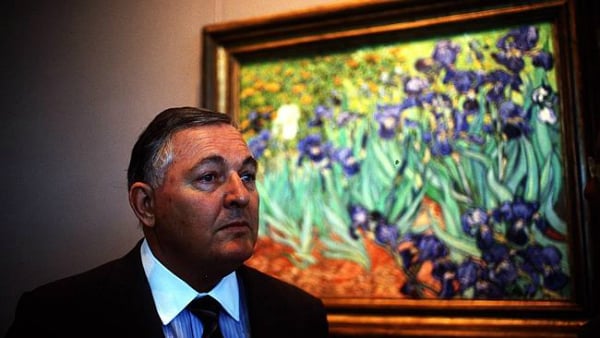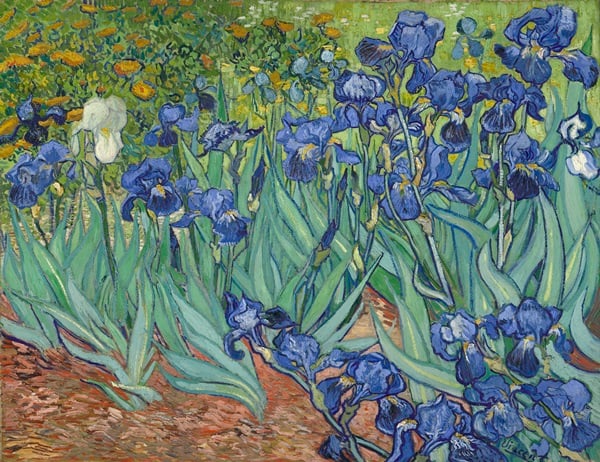Law & Politics
Australian Tycoon Alan Bond, Who Bought Vincent van Gogh’s ‘Irises’ for Record $54 Million in 1987, Is Dead at 77
But the sale was considered "manipulated."

Photo: Adelaide Now
But the sale was considered "manipulated."

Amah-Rose Abrams


Vincent van Gogh, Irises, (1889)
Photo: Courtesy of The J. Paul Getty Museum, Los Angeles
Australian ex-billionaire, and one time owner of Vincent van Gogh’s The Irises (1889), Alan Bond died on Friday following heart surgery. He was 77.
Bond left school at 16 and worked as a sign painter before starting out as a property developer during the 1960s and becoming a millionaire by the tender age of 21. Bond, who was a property developer, was best known for financing Australia’s successful bid for the 1983 America’s Cup. He was also involved in Australia’s most well-known corporate fraud for which he spent four years in jail.
Bond bought Van Gogh’s Irises at Sotheby’s New York in 1987 for $53.9 which, at that time was the highest amount ever paid for a painting. Initially, the sale was kept anonymous with Bond only going public about the record purchase when his penthouse office, where the painting was hung, was finished in 1988.
”It’s not just a painting,” Mr. Bond told reporters according to the New York Times. ”It’s the most important painting in the world.” Bond reportedly couldn’t pay for the painting and in 1990 sold it to the J. Paul Getty Museum in Los Angeles for an undisclosed sum.

Alan Bond with Van Gogh’s Irises
Photo via: Adelaide Now
But it was revealed, roughly two years later, that Sotheby’s had lent Bond $27 million and that he hadn’t yet paid for the work, which led critics to call it a “manipulated sale.” Here’s an excerpt about the sale from our story 10 Game-Changing Auctions:
When Australian financier Alan Bond shelled out $53.9 million for Vincent Van Gogh‘s Irises, less than one month after the massive stock market crash on October 19th it set the record for the world’s most expensive painting. It also created an inflated level of confidence about the ability of the art market—or at least masterpieces of this caliber—to withstand a brutal economic downturn. But nearly two years later, it was revealed that Sotheby’s had lent Bond roughly $27 million, or more than half, of the purchase price and that he wasn’t yet paid up. The house also admitted it was still in control of Irises and was storing it at an undisclosed location. Observers called it a “manipulated sale,” compared it to buying on margin, said it was not a “real” price, and lamented the fact that it had become such a significant benchmark in the marketplace. Three years later, the Los Angeles—based J. Paul Getty Museum bought Irises from Bond in a deal brokered by Sotheby’s. The price has never been disclosed and it still hangs in the Getty today. Sotheby’s Financial Services tightened its loan policies considerably as a result of the Bond debacle.
In 1992, Bond declared bankruptcy after failing to pay back $194 million from a personal guarantee he made on a loan to a former nickel mining project, according to the International New York Times. At the time of his bankruptcy, his personal debts reportedly totaled $1.8 billion. In 1995, his family paid creditors $12 million and bought Bond out of bankruptcy.
Bond was a passionate collector of Impressionist and Post-Impressionist works and he owned paintings by Paul Gauguin, Auguste Renoir, Henri de Toulouse-Lautrec, and Pablo Picasso. His favorite painting in the collection was reported to be Camille Pissarro’s Peasant at Sunset (1892).

Edouard Manet, La Promenade (Mme Gamby) (1880)
Photo via: Wikipedia
Perhaps his most scandalous acquisition was La Promenade (1880) by Édouard Manet, which his family company Dallhold bought for $2.4 million and sold for $17 million a year later. The last time the painting was sold at auction according to the artnet Price Database was 1989 at Sotheby’s New York where it was purchased for $14.85 million. (See $65 Million Manet Leads at Christie’s $165 Million Impressionist and Modern Art Sale and The 10 Most Expensive Auction Trophies of 2014.)
In 1996 he was handed a three-year prison sentence after being convicted for wrongly using his position as a director of the public company Bond Corp. in several transactions, which not only cost the company millions of dollars but also enabled his family company to purchase Manet’s painting at a steep discount.
The following year, he pleaded guilty to more charges from prison and was sentenced to seven years in prison for defrauding his own company, Bell Resources, out of $935 million.
Bond polarized opinion in Australia and abroad, and while there had been discussion of an Australian state funeral, this has now been ruled out. The family has gathered at their home in Perth, Australia and those who would like to remember him as an art lover can remember him through Van Gogh (see Celebrate Vincent van Gogh’s Birthday with His Top 10 Paintings and Rare Van Gogh Still Life Could Bring $50 Million at Sotheby’s).